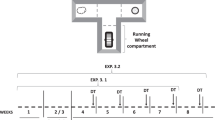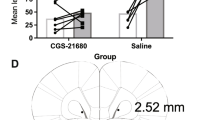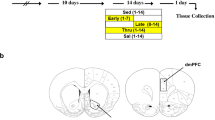Abstract
Rationale
Mesolimbic dopamine (DA) regulates behavioral activation and effort-related decision-making in motivated behaviors. Mesolimbic DA D2 receptors are co-localized with adenosine A2A receptors, and they interact in an antagonistic manner.
Objectives
A T-maze task was developed to assess dopaminergic involvement in preference between a reinforcer that involves vigorous voluntary activity (running wheel) and a reinforcer that requires minimal behavioral activation (sucrose pellets). Haloperidol (D2 antagonist) was administered to adenosine A2A receptor knockout (A2AKO) and wild-type (WT) littermate controls to assess the involvement of these two receptors in the selection of running wheel activity versus sucrose consumption.
Results
Under control conditions, mice spent more time running and less time eating. In WT mice, haloperidol reduced time running but actually increased time-consuming sucrose. However, A2AKO mice did not show the haloperidol-induced shift from running wheel activity to sucrose intake. Prefeeding reduced sucrose consumption in the T-maze in both strains, indicating that this paradigm is sensitive to motivational devaluation. Haloperidol increased c-Fos immunoreactivity in anterior cingulate cortex (ACg) and nucleus accumbens (Acb) core of WT but not KO mice.
Conclusions
These results indicate that after DA antagonism, the preference for vigorous physical activity is reduced, while palatable food selection increases. Adenosine A2A receptor deletion provides resistance to these effects of D2 receptor antagonism. These two receptors in Acb core and ACg seem to be involved in the regulation of the intrinsic reinforcing characteristics of voluntary exercise but not in the regulation of the primary reinforcing characteristics of palatable sedentary reinforcers.





Similar content being viewed by others
References
Aberman JE, Salamone JD (1999) Nucleus accumbens dopamine depletions make rats more sensitive to high ratio requirements but do not impair primary food reinforcement. Neuroscience 92:545–552
Bakshi VP, Kelley AE (1991) Dopaminergic regulation of feeding behavior: I. differential effects of haloperidol microinjection in three striatal subregions. Psychobiology 19:223–232
Baldo BA, Sadeghian K, Basso AM, Kelley AE (2002) Effects of selective dopamine D1 or D2 receptor blockade within nucleus accumbens subregions on ingestive behavior and associated motor activity. Behav Brain Res 137:165–177
Baum WM, Rachlin HC (1969) Choice as time allocation. J Exp Anal Behav 12:861–874
Beeler JA, Frazier CR, Zhuang X (2012) Putting desire on a budget: dopamine and energy expenditure, reconciling reward and resources. Front Integr Neurosci 6:49
Belke TW, Pierce WD (2014) Effect of sucrose availability and pre-running on the intrinsic value of wheel running as an operant and a reinforcing consequence. Behav Process 103:35–42
Belke TW, Wagner JP (2005) The reinforcing property and the rewarding aftereffect of wheel running in rats: a combination of two paradigms. Behav Process 68(2):165–172
Belke TW, Oldford AC, Forgie MY, Beye JA (2005) Responding for sucrose and wheel-running reinforcement: effect of D-amphetamine. Behav Pharmacol 16:219–225
Berchicci M, Menotti F, Macaluso A, Di Russo F (2013) The neurophysiology of central and peripheral fatigue during sub-maximal lower limb isometric contractions. Front Hum Neurosci 7:135
Berridge KC (2000) Measuring hedonic impact in animals and infants: microstructure of affective taste reactivity patterns. Neurosci Biobehav Rev 24:173–198
Cagniard B, Balsam PD, Brunner D, Zhuang X (2006) Mice with chronically elevated dopamine exhibit enhanced motivation, but not learning, for a food reward. Neuropsychopharmacology 31:1362–1370
Cosgrove KP, Hunter RG, Carroll ME (2002) Wheel-running attenuates intravenous cocaine self-administration in rats: sex differences. Pharmacol Biochem Behav 73:663–671
Dishman RK, Berthoud HR, Booth FW, Cotman CW, Edgerton R, Fleshner MR, Gandevia SC, Gomez-Pinilla F, Greenwood BN, Hillman CH, Kramer AF, Levin BE, Moran TH, Russo-Neustadt AA, Salamone JD, Van Hoomissen JD, Wade CE, York DA, Zigmond MJ (2006) Neurobiology of exercise. Obesity 14:345–356
El Yacoubi M, Ledent C, Parmentier M, Costentin J, Vaugeois JM (2001) Adenosine A2A receptor knockout mice are partially protected against drug-induced catalepsy. Neuroreport 12:983–986
Farrar AM, Segovia KN, Randall PA, Nunes EJ, Collins LE, Stopper CM, Port RG, Hockemeyer J, Müller CE, Correa M, Salamone JD (2010) Nucleus accumbens and effort-related functions: behavioral and neural markers of the interactions between adenosine A2A and dopamine D2 receptors. Neuroscience 166:1056–1067
Ferré S, Ciruela F, Canals M, Marcellino D, Burgueno J, Casadó V, Hillion J, Torvinen M, Fanelli F, Benedetti PD, Goldberg SR, Bouvier M, Fuxe K, Agnati LF, Lluis C, Franco R, Woods A (2004) Adenosine A2A-dopamine D2 receptor-receptor heteromers. Targets for neuro-psychiatric disorders. Parkinsonism Relat Disord 10:265–271
Floresco SB (2015) The nucleus accumbens: an interface between cognition, emotion, and action. Annu Rev Psychol 66:25–252
Floresco SB, St Onge JR, Ghods-Sharifi S, Winstanley CA (2008a) Cortico-limbic-striatal circuits subserving different forms of cost-benefit decision-making. Cogn Affect Behav Neurosci 8:375–389
Floresco SB, Tse MT, Ghods-Sharifi S (2008b) Dopaminergic and glutamatergic regulation of effort- and delay-based decision making. Neuropsychopharmacology 33:1966–1979
Friedman JH (2009) Fatigue in Parkinson’s disease patients. Curr Treat Options Neurol 11:186–190
Ghods-Sharifi S, Floresco SB (2010) Differential effects on effort discounting induced by inactivations of the nucleus accumbens core or shell. Behav Neurosci 124:179–191
Hauber W, Sommer S (2009) Prefrontostriatal circuitry regulates effort-related decision making. Cereb Cortex 19:2240–2247
Hosking JG, Floresco SB, Winstanley CA (2015) Dopamine antagonism decreases willingness to expend physical, but not cognitive, effort: a comparison of two rodent cost/benefit decision-making tasks. Neuropsychopharmacology 40:1005–1015
Ikemoto S, Panksepp J (1996) Dissociations between appetitive and consummatory responses by pharmacological manipulations of reward-relevant brain regions. Behav Neurosci 110:331–345
Keppel G (1991) Design and analysis: a researcher’s handbook. Prentice-Hall, Englewood Cliffs
Lambert KG (2006) Rising rates of depression in today’s society: consideration of the roles of effort based rewards and enhanced resilience in day-to-day functioning. Neurosci Biobehav Rev 30:497–510
Ledent C, Vaugeois JM, Schiffmann SN, Pedrazzini T, El Yacoubi M, Vanderhaeghen JJ, Costentin J, Heath JK, Vassart G, Parmentier M (1997) Aggressiveness, hypoalgesia and high blood pressure in mice lacking the adenosine A2a receptor. Nature 388:674–678
Lett BT, Grant VL, Byrne MJ, Koh MT (2000) Pairings of a distinctive chamber with the aftereffect of wheel running produce conditioned place preference. Appetite 34:87–94
Levine AS, Kotz CM, Gosnell BA (2003) Sugars: hedonic aspects, neuroregulation, and energy balance. Am J Clin Nutr 78:834S–842S
Mai B, Sommer S, Hauber W (2012) Motivational states influence effort-based decision making in rats: the role of dopamine in the nucleus accumbens. Cogn Affect Behav Neurosci 12:74–84
McMillan DE, McClure GY, Hardwick WC (1995) Effects of access to a running wheel on food, water and ethanol intake in rats bred to accept ethanol. Drug Alcohol Depend 40:1–7
Mueller DT, Loft A, Eikelboom R (1997) Alternate-day wheel access: effects on feeding, body weight, and running. Physiol Behav 62:905–908
Nunes EJ, Randall PA, Hart EE, Freeland C, Yohn S, Baqi Y, Müller CE, Lopez-Cruz L, Correa M, Salamone JD (2013) Effort-related motivational effects of the VMAT-2 inhibitor tetrabenazine: implications for animal models of the motivational symptoms of depression. J Neurosci 33:19120–19130
Pardo M, Lopez-Cruz L, Valverde O, Ledent C, Baqi Y, Müller CE, Salamone JD, Correa M (2012) Adenosine A2A receptor antagonism and genetic deletion attenuate the effects of dopamine D2 antagonism on effort-based decision making in mice. Neuropharmacology 62:2068–2077
Pardo M, Lopez-Cruz L, Valverde O, Ledent C, Baqi Y, Müller CE, Salamone JD, Correa M (2013) Effect of subtype-selective adenosine receptor antagonists on basal or haloperidol-regulated striatal function: studies of exploratory locomotion and c-Fos immunoreactivity in outbred and A2AR KO mice. Behav Brain Res 247:217–226
Pardo M, Lopez-Cruz L, San Miguel N, Salamone JD, Correa M (2015) Selection of sucrose concentration depends on the effort required to obtain it: studies using tetrabenazine, D1, D2 and D3 receptor antagonists. Psychopharmacology 232:2377–2391
Peciña S, Cagniard B, Berridge KC, Aldridge JW, Zhuang X (2003) Hyperdopaminergic mutant mice have higher “wanting” but not “liking” for sweet rewards. J Neurosci 23:9395–9402
Pereira M, Farrar AM, Hockemeyer J, Müller CE, Salamone JD, Morrell JI (2011) Effect of the adenosine A2A receptor antagonist MSX-3 on motivational disruptions of maternal behavior induced by dopamine antagonism in the early postpartum rat. Psychopharmacology 213:69–79
Pierce WD, Epling WF, Boer DP (1986) Deprivation and satiation: the interrelations between food and wheel running. J Exp Anal Behav 46:199–210
Pinna A, Wardas J, Cozzolino A, Morelli M (1999) Involvement of adenosine A2A receptors in the induction of c-fos expression by clozapine and haloperidol. Neuropsychopharmacology 20:44–51
Premack D, Premack AJ (1963) Increased eating in rats deprived of running. J Exp Anal Behav 6:209–212
Randall PA, Pardo M, Nunes EJ, López-Cruz L, Vemuri VK, Makriyannis A, Baqi Y, Müller CE, Correa M, Salamone JD (2012) Dopaminergic modulation of effort-related choice behavior as assessed by a progressive ratio chow feeding choice task: pharmacological studies and the role of individual differences. PLoS One 7:e47934
Robbins TW, Everitt BJ (2007) A role for mesencephalic dopamine in activation: commentary on Berridge (2006). Psychopharmacology 191:433–437
Routtenberg A (1968) “Self-starvation” of rats living in activity wheels: adaptation effects. J Comp Physiol Psychol 66:234–238
Salamone JD (1988) Dopaminergic involvement in activational aspects of motivation: effects of haloperidol on schedule induced activity, feeding and foraging in rats. Psychobiology 16:196–206
Salamone JD, Correa M (2002) Motivational views of reinforcement: implications for understanding the behavioral functions of nucleus accumbens dopamine. Behav Brain Res 137:3–25
Salamone JD, Correa M (2009) Dopamine/adenosine interactions involved in effort-related aspects of food motivation. Appetite 53:422–425
Salamone JD, Correa M (2012) The mysterious motivational functions of mesolimbic dopamine. Neuron 76:470–485
Salamone JD, Zigmond MJ, Stricker EM (1990) Characterization of the impaired feeding behavior in rats given haloperidol or dopamine depleting brain lesions. Neuroscience 39(17):24
Salamone JD, Steinpreis RE, McCullough LD, Smith P, Grebel D, Mahan K (1991) Haloperidol and nucleus accumbens dopamine depletion suppress lever pressing for food but increase free food consumption in a novel food choice procedure. Psychopharmacology 104:515–521
Salamone JD, Mahan K, Rogers S (1993) Ventrolateral striatal dopamine depletions impair feeding and food handling in rats. Pharmacol Biochem Behav 44:605–610
Salamone JD, Cousins MS, Bucher S (1994) Anhedonia or anergia? effects of haloperidol and nucleus accumbens dopamine depletion on instrumental response selection in a T-maze cost/benefit procedure. Behav Brain Res 65:221–229
Salamone JD, Correa M, Nunes EJ, Randall PA, Pardo M (2012) The behavioral pharmacology of effort-related choice behavior: dopamine, adenosine and beyond. J Exp Anal Behav 97:125–146
Santerre JL, Nunes EJ, Kovner R, Leser CE, Randall PA, Collins-Praino LE, Lopez-Cruz L, Correa M, Baqi Y, Müller CE, Salamone JD (2012) The novel adenosine A(2A) antagonist prodrug MSX-4 is effective in animal models related to motivational and motor functions. Pharmacol Biochem Behav 102:477–487
Schweimer J, Saft S, Hauber W (2005) Involvement of catecholamine neurotransmission in the rat anterior cingulate in effort-related decision making. Behav Neurosci 119:1687–1692
Sherwin CM (1998) Voluntary wheel running: a review and novel interpretation. Anim Behav 56:11–27
Smith MA, Schmidt KT, Iordanou JC, Mustroph ML (2008) Aerobic exercise decreases the positive reinforcing effects of cocaine. Drug Alc Depend 988:129–135
Treadway MT, Buckholtz JW, Cowan RL, Woodward ND, Li R, Ansari MS, Baldwin RM, Schwartzman AN, Kessler RM, Zald DH (2012) Dopaminergic mechanisms of individual differences in human effort-based decision-making. J Neurosci 32:6170–6176
Acknowledgments
This work was supported by a grant to Mercè Correa from Pla Promoció Investigació UJI (P1.1 A 2013-01), to John D. Salamone from the National Institute of Mental Health (MH078023), and to Olga Valverde from Ministery of Economy, Spain (SAF-2013-41761-R). Personal grants were awarded to Marta Pardo (Predoc-UJI/ 2007/43), Noemí San Miguel (Predoc-UJI/2012/28), and Laura Lopez-Cruz (FPU AP2010-3793, Ministerio de Educación, Spain).
Author information
Authors and Affiliations
Corresponding authors
Rights and permissions
About this article
Cite this article
Correa, M., Pardo, M., Bayarri, P. et al. Choosing voluntary exercise over sucrose consumption depends upon dopamine transmission: effects of haloperidol in wild type and adenosine A2AKO mice. Psychopharmacology 233, 393–404 (2016). https://doi.org/10.1007/s00213-015-4127-3
Received:
Accepted:
Published:
Issue Date:
DOI: https://doi.org/10.1007/s00213-015-4127-3




